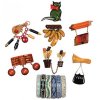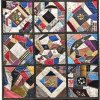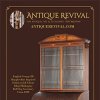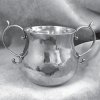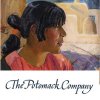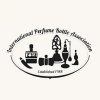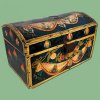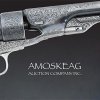The 2017 Lititz Antiques Show
June 24th, 2017
Lititz, Pennsylvania
The town of Lititz, in the fertile farmland of Lancaster County, Pennsylvania, has a group of dedicated residents who have preserved the rich history of the area. The year after the Lititz Historical Society was founded in 1961, the society held an antiques show as a fund-raiser, and every year since then the show has gone on. The 55th annual Lititz Antiques Show to benefit the Johannes Mueller House on East Main Street took place at the Warwick Middle School on June 23 and 24.
Fifty dealers, most of them Pennsylvanians and a few from New Hampshire, Vermont, Alabama, and Ohio, had country gear for sale to locals and to those who always come to the region for late spring antiquing. The show had a lot of energy. With the demise of the Oley show in Montgomery County, some of the dealers and many of the shoppers were glad to see that show manager Henry “Smitty” Paul had figured out how to put on a tabletop (or bring-your-own-walls) show with reasonable booth rents so that dealers can make a few bucks and enjoy the fellowship that antiques shows provide. Paul said attendance has gone up every year since the show moved to the air-conditioned Warwick Middle School three years ago. A record 600-plus came to the show this year; over 100 were in line when the show opened. Among them were some dealers who exhibit at major shows. Selling was brisk in the first few hours, and one dealer said that he made five sales during the last hour of the show, which closed at 2 p.m. on Saturday. Paul said that some dealers have done the show for 30 years, others for more than ten, and that this show is one of the few that has a waiting list.

This red, white, and blue linsey-woolsey make-do patchwork quilt, found in Connecticut, was $900 from American Vernacular.

Ellen Katona and Bob Lutz of Shiloh, New Jersey, offered some lanterns. These three were (from left) $245, $225, and $295.

This early 20th-century German putz village was $495 from Cheryl Mackley of Red Lion, Pennsylvania.
Lititz is a lighthearted show that seems like a treasure hunt. Dealers offered a rare oval Nantucket basket signed by its maker, a group of squirrel cages, a graduated set of three large cheese baskets, and a carrying case for fighting cocks. Where else could you find a rabbit trade stimulator that appears to eat its carrot? A Seneca Indian beadwork pouch as bright and crisp as the day it was made had a design that approached perfection. An Arcade cast-iron Yellow Cab is now a relic of the age before Lyft and Uber. A silhouette portrait of Quaker couple Aaron Ivins and his wife, by Rosalie Bye, a West Chester, Pennsylvania, artist, was made from Quaker felt and silk clothes. The work was signed “R.P. Bye” at the base of the brick wall painted in watercolor for the background. The subjects are identified on the back of the picture. Ivins was a mathematician and founder and principal of the Friends’ Central School in Philadelphia. An additional note says it was made for the Ivinses’ granddaughter in 1933.
The antiques show is not the only reason to go to Lititz. Just nine miles north of Lancaster, Pennsylvania, it is a charming town where the earliest boarding and day school for girls, Linden Hall, was founded in 1746. There are several good restaurants. Ducks float down the spring-fed canal in the idyllic Lititz Springs Park. The longest continuous Fourth of July celebration has taken place in the park every year since 1818. The Wilbur Chocolate Company has a big new store on Broad Street, and the Julius Sturgis Pretzel Bakery on Main Street is the first commercial pretzel factory in America. It was founded in 1861. There is a farmers market on Thursdays from 4:30 p.m. until dusk, May through October. Farm stands can be found on the country roads in the surrounding Amish county. Lititz has been called “the hometown everyone wishes were theirs.”

“Be Kindly Affectioned one towards another” stitched Margaret Graham in 1803 in England. The sampler was $495 from Rich Gryziec of RSG Antiques, Hanover Township, Pennsylvania.

The Shakers sold these sewing kits to tourists in the late 19th/early 20th centuries. Paul and Nancy Hahn asked $385, $225, and $335. The center one has a special place for scissors and for a thimble under the flap.

Jim and Diane Farr of Boalsburg, Pennsylvania, asked $400 for the Amish crib quilt in blue, turquoise, green, and hot pink on a black ground. The box of spice canisters patented in the 1860s in Newark, New Jersey, was $2250. The two candle molds were $195 each; the shorter one sold. The pewter candlesticks were made in Cincinnati, Ohio, in the 19th century; they were $250.
How did Lititz get its name? Moravians settled in Warwick Township in the 1740s and founded Lititz as a Moravian town. They named it in 1756 for an old Gothic castle that is located in northeastern Bohemia (today the Czech Republic) near the Silesia/Moravia border. Early Moravian Brethren, followers of the martyred John Hus, had found refuge in this castle in 1457 and named it “Lidice nad Citadelou” meaning “people of the castle.”
 The Lititz Historical Foundation runs the Lititz Museum in the 1793 Christian Schropp House, which tells the story of the first inhabitants of Lititz, the Native Americans, and tells about the Pennsylvania traditions of fraktur and stitchery.
The Lititz Historical Foundation runs the Lititz Museum in the 1793 Christian Schropp House, which tells the story of the first inhabitants of Lititz, the Native Americans, and tells about the Pennsylvania traditions of fraktur and stitchery.
The story of General John Sutter is also told. The Swiss/German pioneer is best known for his role in the Gold Rush and the founding of Sacramento, California. He came back east and settled in Lititz, in part because of its proximity to Washington, D.C., where he unsuccessfully petitioned Congress for money owed to him for quartering U.S. troops at his fort in California.

Francis Crespo of Lancaster, Pennsylvania, asked $195 for these fancy chairs painted with an Aesthetic Movement design.

Did you know that an early version (circa 1860) of the straight pin was the toilet pin with a glass head? Imported from Germany, they came stuck in paper cubes. The larger cubes were $45; the smaller ones, $18, from Candy Fluman of Dillsburg, Pennsylvania.

Brian Hart of Oley Valley Antiques, Fleetwood, Pennsylvania, sold the quilt rack and the ladder-back chair; the cart was $250, and the baskets in it were priced from $45 to $85.
Next door at the 1792 Johannes Mueller House, visitors get a glimpse of everyday life of the Moravian dyer, his family, and apprentices. The Moravians who bought land and built their houses on Main Street were given two acres to plant in flax. They brought their homespun yarn to Mueller to dye. Behind the museum buildings, the Mary Oehme Gardens can be enjoyed when they are not rented for a wedding or reception.
Lititz is perfect for a day trip from Philadelphia or for a weekend getaway. The Lititz website has a long list of inns and bed and breakfasts (www.lititzpa.com), and Main Street is lined with shops.
For more information, see (www.lititzhistoricalfoundation.com).

McClearen Antiques, Manheim, Pennsylvania, asked $895 for the hooked rug. The blue-painted trencher was $675; the preserve jar labeled for anchovies was $395; the weighted tin lamp stand was $125; the yellow box with a handle, $395; and the small blue box on it, $295.

This set of four cheese baskets was $600 from Patrick Murray of Paradise Village Antiques, Paradise, Pennsylvania.

These dozen advertising fly swatters were $95 for the collection or $12 each from David Tuttle. They advertised a funeral home, a hauling company, a lightning rod company, a dairy farm, and the Penn State Electric Company.
Originally published in the September 2017 issue of Maine Antique Digest. © 2017 Maine Antique Digest






